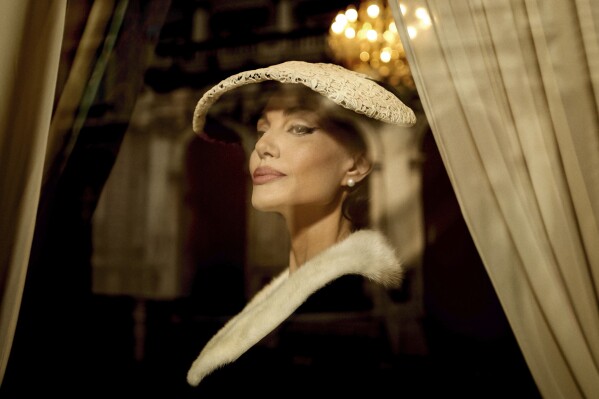Her voice was not a typical beauty. It had hard edges and dark recesses, and she eschewed the dutiful precision of other bel canto artists. With devoted study and deep thought, she unleashed her art from convention. The defiant unique wildness that resulted is what has turned some listeners off, and what brings the living electrical charge to the rest of us who thrill to hear her.
https://www.youtube.com/watch?v=du4L5ikk5Ms
Unfortunately, Maria, the new biopic of Callas, depicts very little of what made her so unique and unforgettable an artist.
The director, Chilean filmmaker Pablo Larraín, has focused instead on the sensationalised glamour and tragedies of her public life, blended with the well-trod stereotype of the tortured artist hounded by trauma.
Maria stars Angelina Jolie, and is set over the seven days preceding Callas’s death, at the age of 53, in her Paris apartment. She has hired a rehearsal pianist to prepare her for a new performance. What performance, exactly, she has in mind and would like to prepare for is never made clear.
Her struggle is with her voice, which has lost much of its power, and the most agonised scenes are the ones where Maria despairs over the loss of her vocal abilities, which Jolie renders with heart-wrenching physical and emotional anguish.
In between scenes of rehearsal and interactions with her two devoted household staff members, Maria leads an imaginary interviewer around Paris, where she reflects on her life, replete with flashbacks and reminiscences.
 Angelina Jolie in Maria. (Photo: Netflix)
Angelina Jolie in Maria. (Photo: Netflix)
Opera lovers are thrown numerous treats: the Anvil Chorus and Humming Chorus are rendered, phantasmagorical, on the streets of Paris during Maria’s walks, there are significant excerpts from Norma and I Puritani, a dramatic rendering of Tosca’s moving Vissi d’arte, and the Ave Maria from Verdi’s Otello plays repeatedly like a poignant motif for a radiant life nearing its close.
The film’s timelines alternate between black and white, with a luxurious amber glow.
Maria is gorgeously shot by Ed Lachman. It boasts further exquisite visual pleasures in the sets, designed by Guy Dyas, and costumes by Massimo Parrini. Many shots are meticulously set up to replicate instantly recognisable photos and clips of Callas.
But these amount only to beautiful surfaces.
 Angelina Jolie attends the premiere of Maria during the 2024 AFI Fest at the TCL Chinese Theatre i. Hollywood on 26 October 2024. (Photo: Monica Schipper / Getty Images)
Angelina Jolie attends the premiere of Maria during the 2024 AFI Fest at the TCL Chinese Theatre i. Hollywood on 26 October 2024. (Photo: Monica Schipper / Getty Images)
 Angelina Jolie at the Maria headline gala during the 68th BFI London Film Festival at the Royal Festival Hall on 18 October 2024. (Photo: Joe Maher/Getty Images for BFI)
Angelina Jolie at the Maria headline gala during the 68th BFI London Film Festival at the Royal Festival Hall on 18 October 2024. (Photo: Joe Maher/Getty Images for BFI)
The flashbacks highlight only the most heavily sentimentalised headlines of Callas’s life, like her affair with Aristotle Onassis, her troubled relationship with her family, and an adversarial press. When fans or critics praise her, they don’t even mention for what, other than vague praise for “the voice” or musical “perfection”.
Above all, the scenery and stories elide what made Callas so singular an artist.
No performance or role is shown to mean anything significant to her, other than mounting success and adoration. There is no indication of the study and thought she devoted to the music she sang. Even in scenes of her singing, there is no directorial indication of what made Callas’s singing so special.
The film doesn’t highlight her dramatic prowess, her intimate and eloquent portrayals, or the thrumming personality and presence she brought on stage.
“La Callas” wasn’t adored for her own sake: Why was Callas a worthwhile artist in the first place? Larraín leaves it to you to find out for yourself, somewhere outside of his movie.
Where his vision of Callas does indeed come to life is in her imperious evocation by Jolie.
Jolie is a performer of sufficient weight and charisma to meaningfully embody a worldwide icon like Callas. And Jolie’s own mercurial spirit and commanding presence lights a screen ablaze, to conjure the living, breathing mystery of an artist whose mind is at work.
If Maria stays with you at all, it will be Jolie’s image that lingers. DM
Maria will open in theatres on 31 January 2025.




 LONDON, ENGLAND - OCTOBER 18: Angelina Jolie attends the "Maria" Headline Gala during the 68th BFI London Film Festival at The Royal Festival Hall on October 18, 2024 in London, England. (Photo by Joe Maher/Getty Images for BFI)
LONDON, ENGLAND - OCTOBER 18: Angelina Jolie attends the "Maria" Headline Gala during the 68th BFI London Film Festival at The Royal Festival Hall on October 18, 2024 in London, England. (Photo by Joe Maher/Getty Images for BFI) 